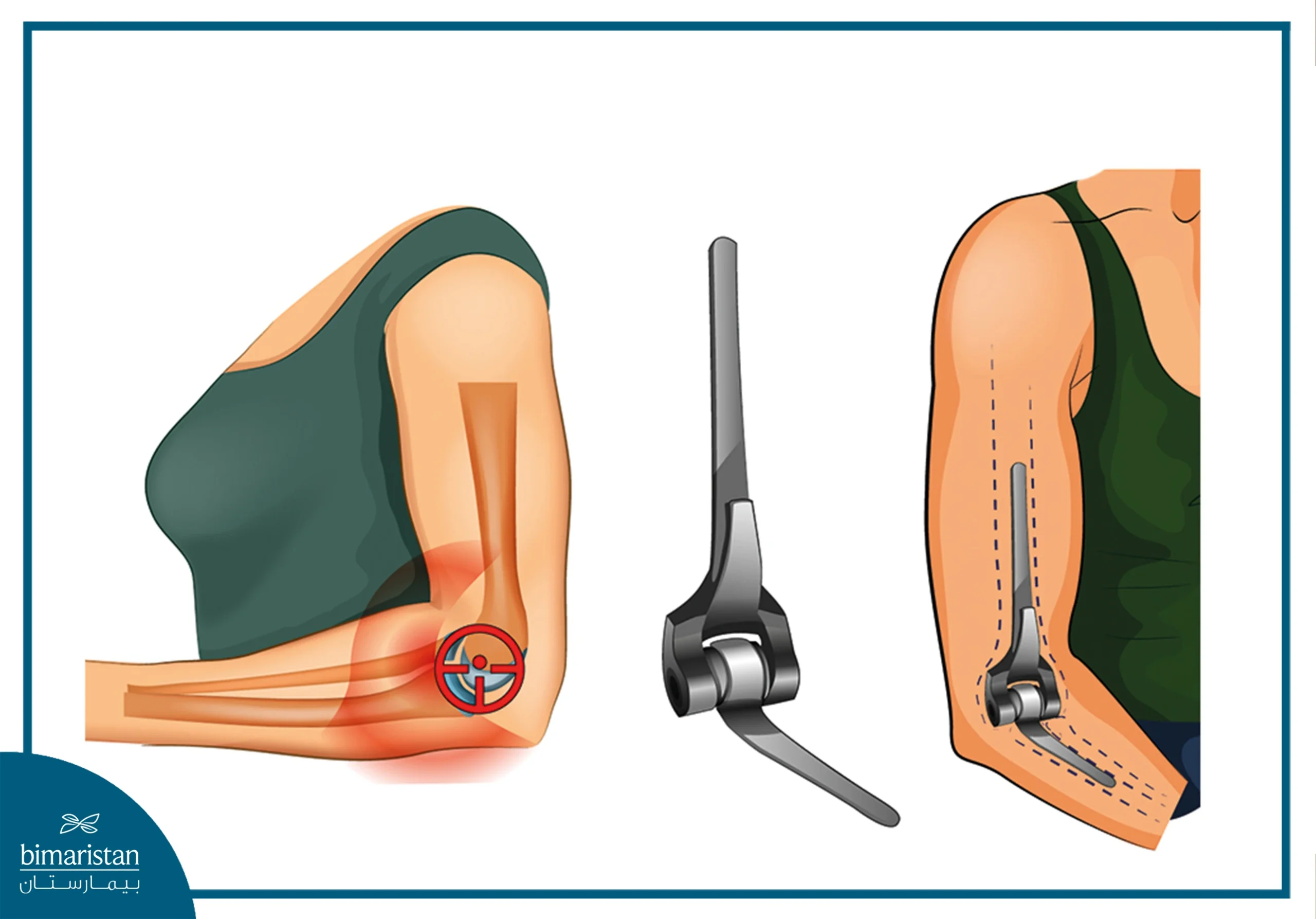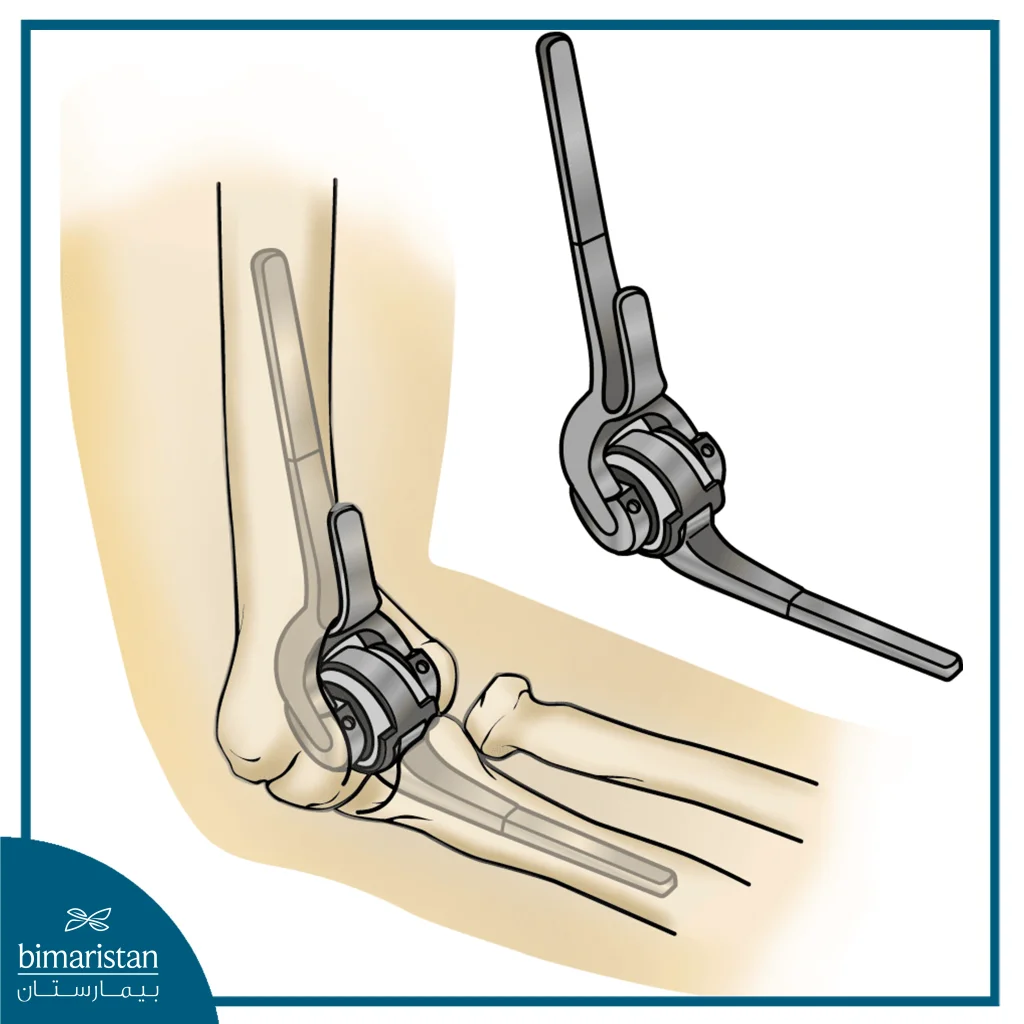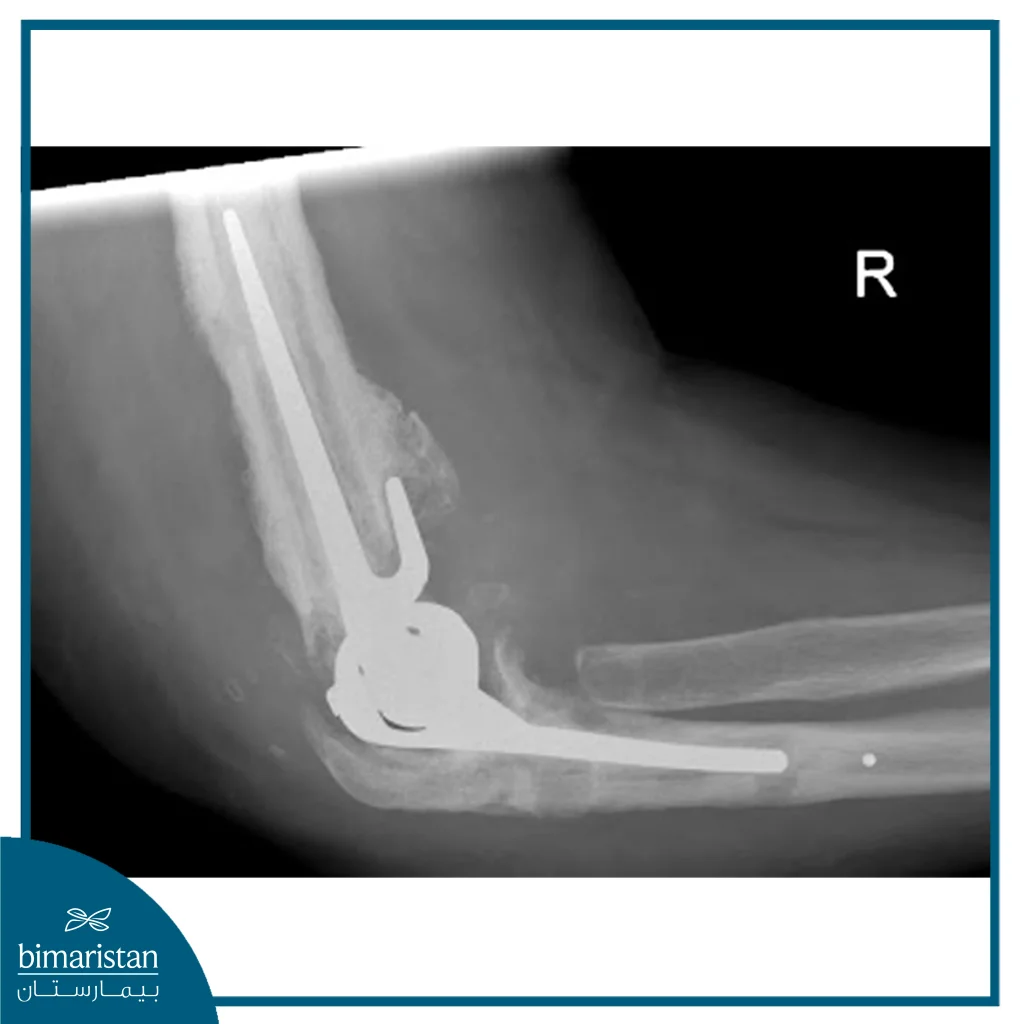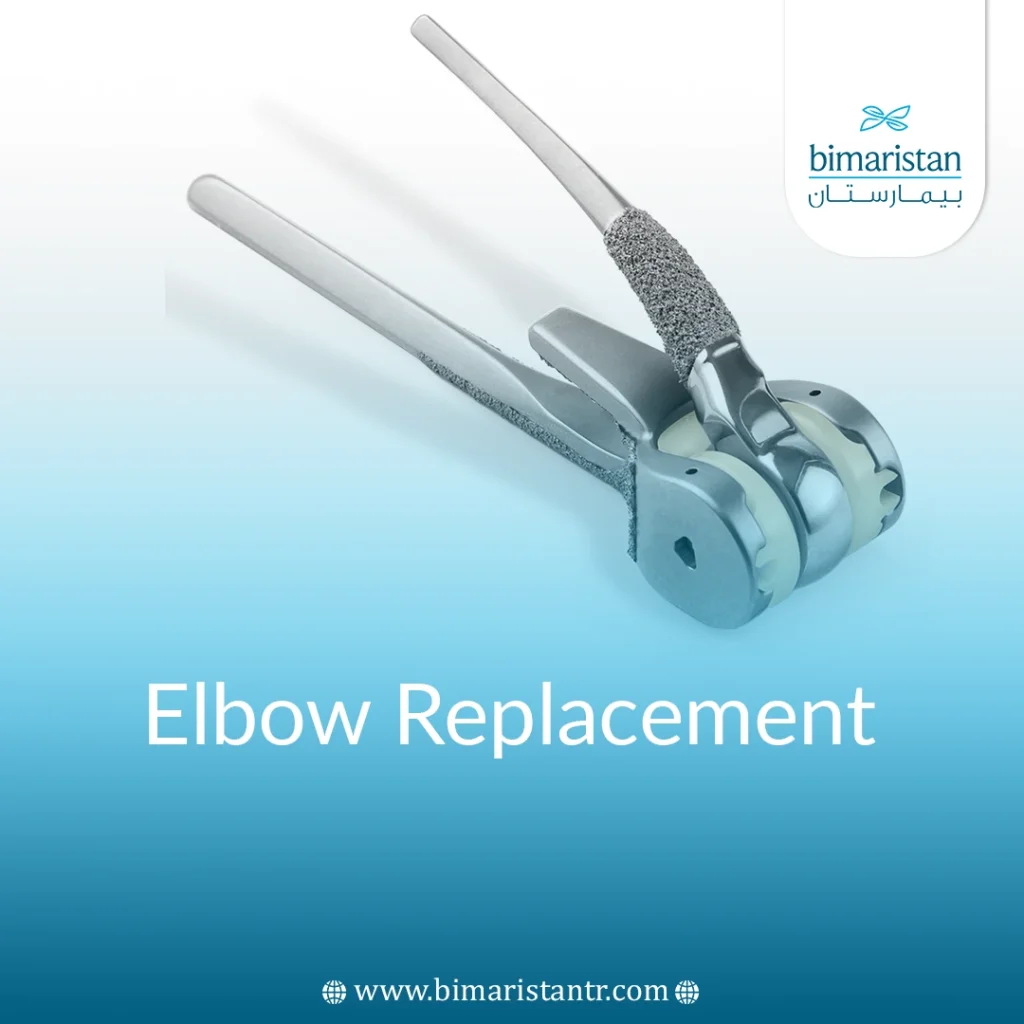Elbow replacement surgery (also called elbow arthroplasty) treats problems caused by arthritis in the elbow. It has become the most commonly used procedure in older adults to replace joints damaged by fractures.
More than 90% of patients with elbow replacement surgery in Turkey consider their artificial elbows successful.
The elbow joint is made up of three bones: the upper arm bone (humerus), the lower arm bone on the thumb side (radius), and the lower arm bone on the little finger side (ulna).
The humerus and ulna meet to form a joint that allows your arm to bend.
The way the humerus and radius connect allows the lower arm to rotate between palm-up and palm-down positions.

Elbow replacement is a major surgery that carries significant risks and potential complications.
Why is elbow replacement surgery necessary?
Joint replacement surgery is usually considered a last resort for severely damaged elbow joints after all other methods have been exhausted. An artificial joint replaces damaged surfaces with metal and plastic designed to fit together and rub together smoothly.
This, in turn, eliminates the pain of bones rubbing against each other.
The most common reason for an artificial elbow replacement is arthritis.
There are two main types of arthritis: degenerative and rheumatoid.
Degenerative arthritis is also called wear-and-tear arthritis or osteoarthritis.
Any injury to the elbow can damage the joint and lead to degenerative arthritis.
However, arthritis may not appear for many years after the injury.
There are also several types of systemic arthritis.
The most common form is rheumatoid arthritis. All types of systemic arthritis are diseases that affect many or even all of the joints in the body.
Systemic arthritis destroys the lining of the joint’s articular cartilage.
Elbow replacement may also be done immediately after certain types of elbow fractures, usually in older adults.
Because elbow fractures are difficult to repair surgically in many older adults, the bone may also be weakened by osteoporosis.
(People with osteoporosis have less dense bones than they should be.) Weak bones make it very difficult for the surgeon to use metal plates and screws to hold the broken parts in place long enough to heal together.
In such cases, removing the broken parts and replacing the elbow with an artificial joint is sometimes better.
You may also be interested in: Knee replacement surgery in Turkey
What do I need to know before surgery?
You and your surgeon should decide whether to proceed with surgery together.
You need to understand as much as possible about elbow replacement surgery in Turkey.
If you have concerns or questions, you should talk to your surgeon.
Once you have decided on surgery, you will need to take several steps. Your surgeon may suggest that your regular doctor perform a complete physical examination. This exam helps ensure that you are in the best possible condition for the procedure.
You may also need to spend some time with a physical therapist or physiotherapist who will manage your post-operative rehabilitation.
This will allow you to recover more quickly.
One purpose of this pre-operative visit is to record how well your condition is progressing. Your therapist will check your current pain levels, your ability to perform your activities, and the movement and strength of each elbow.
The second purpose of your preoperative visit with a physical therapist is to prepare you for surgery.
You will begin to learn some exercises that you will use during your recovery.
The therapist can help you anticipate any special needs or problems you may have at home once you are discharged from the hospital.
On the day of your surgery, you will likely be admitted to the hospital early in the morning.
You should not eat or drink anything after midnight the night before your surgery.
Be prepared to stay in the hospital for at least one night.
Elbow replacement surgery

What happens during elbow replacement surgery?
Replacement surgery is usually not performed until symptoms can no longer be controlled without surgery.
If replacement becomes necessary, it can be a very effective way to relieve arthritis pain and restore normal use of your elbow.
Before we describe the procedure, let’s first look at the artificial elbow itself.
The artificial elbow
There is more than one type of artificial elbow joint (also called a prosthesis). The most common type is the hinge joint.
Each prosthesis consists of two parts.
The humeral component replaces the lower end of the humerus bone in the upper arm.
The humeral part of the prosthesis has a long stem that attaches to the hollow center of the humerus bone.
The ulnar part replaces the upper end of the ulna bone in the lower arm.
The ulnar part also has a shorter metal stem that attaches to the hollow center of the ulna bone.
The hinge between the two components is made of metal and plastic. The plastic part is rigid and smooth, allowing the two pieces of the new joint to slide easily against each other as you move your elbow.
The hinge allows your elbow to bend and straighten smoothly.
There are two different ways to hold your artificial elbow in place.
A cemented prosthesis uses a special type of epoxy cement to bond it to your bone.
A non-cemented prosthesis has a fine mesh of holes on the surface.
Over time, bone grows into the mesh, attaching the prosthesis to the bone.
Before elbow replacement surgery
What should I do to prepare for elbow replacement surgery?
This stage is often similar to that of knee and hip replacements.
Your doctor may ask you to stop taking certain medications before elbow replacement surgery. These medications can cause extra bleeding and include:
- Arthritis medications
- Blood thinners
- Nonsteroidal anti-inflammatory drugs (NSAIDs), including ibuprofen and aspirin
You will have limited movement of your arm for several weeks after elbow replacement surgery while you recover.
Before surgery, you may want to move items you use regularly to low shelves in your home so they are easier to reach.
Surgical procedure
Most elbow replacement surgeries are done under general anesthesia (general anesthesia that puts you to sleep).
In some cases, the surgery is done with local anesthesia, which numbs only the nerves in your arm.
If you have local anesthesia, you may also be given medication to help you sleep superficially, so you won’t be aware of the surgery.
After the anesthesia, the surgeon makes an incision in the back of your elbow joint. The incision is made on the back side because most of the blood vessels and nerves are inside your elbow.
Going in from the back side also helps prevent damage to them.
The tendons and ligaments are then moved away from your elbow.
Care must also be taken to move the ulnar nerve, which runs along your elbow to your hand.
Once the joint is exposed, the first step is to remove the joint surfaces of the ulna and radius.
This is usually done with a surgical saw. The surgeon then uses a special device to empty the marrow space inside the ulna to attach the metal stem of the ulnar component.
The ulnar component is then inserted into the bone to test the fit.
When the ulnar component is properly fitted, the surgeon repeats the procedure on the humerus.
After the humeral component is fitted, the surgeon puts the implant parts together and checks to see if the joint is working properly.
The implant is then removed, and the bone is prepared to be held in place.
The pieces are then held in place and put back together. After once again checking for proper fit and movement, the surgeon sutures the incision.
Your elbow will likely be placed in a bulky bandage and splint. You will then be awakened and taken to the recovery room.
Read also: How to replace a knee joint with a robot in Turkey
Complications of elbow replacement surgery
Does elbow replacement surgery cause any complications?
As with all major surgeries, complications can occur. Some of the most common complications after elbow replacement are:
- Anesthesia
- Infection
- Loosening
- Injury to nerves or blood vessels
Anesthesia
Problems can arise when the anesthesia given during surgery causes a reaction to other medications the patient is taking.
In rare cases, a patient may experience problems with the anesthesia itself.
In addition, anesthesia can affect lung function because the lungs do not expand well when a person is under anesthesia.
So, be sure to discuss the risks and concerns with your anesthesiologist.
Infection after elbow replacement surgery
Infection after joint replacement surgery can be very serious.
The chances of developing an infection after most artificial joint replacements are low, about one or two percent.
Elbow replacement has a slightly higher chance of infection for several reasons. One is that the skin around the elbow is thin, and no muscle covers the joint. This makes wound complications more common.
Elbow replacements are also often performed on people with rheumatoid arthritis. Immunosuppressants and medications used to treat this condition affect the body’s immune system, making it harder to fight infections.
Sometimes, the infection shows up very early, before you leave the hospital.
Other times, the infection may not show up for months or even years after the operation.
Infection can also spread to the artificial joint from other infected areas.
Once an infection takes hold in your joint, it’s almost impossible for your immune system to get rid of it.
You may need to take antibiotics when you have dental procedures or procedures on your bladder or colon.
Because antibiotics reduce the risk of germs spreading to the artificial joint.
Loosening
The main reason artificial joints eventually fail is that they become loose when the metal or cement rubs against the bone.
A loose joint implant can cause pain.
If the pain becomes unbearable, another operation may be needed to repair the artificial joint.
Significant progress has been made in extending the life of artificial joints.
However, most implants will eventually come loose and require another surgery.
Younger, more active patients are at higher risk for loosening. An artificial knee joint can last about 12 to 15 years, but artificial elbow joints tend to loosen sooner.
Nerve or blood vessel injury
All of the large nerves and blood vessels that travel to the forearm and hand pass through the elbow joint.
Because the surgery is done near these nerves and blood vessels, it is possible to injure them during surgery.
This injury may be temporary if the nerves are pulled by the spacers that hold them out of the way during the procedure.
Although permanent nerve or blood vessel injury is uncommon, it is possible.
After elbow replacement surgery
What can I expect right after surgery?
After surgery, your elbow will likely be covered with a large bandage and a splint.
Depending on the type of implant used, your elbow will be positioned straight or slightly bent.
You may also have a small plastic tube that drains blood from the joint. The drainage prevents excessive swelling from blood. (This swelling is sometimes called a hematoma.)
The drain tube will likely be removed on the first day. You will then begin assisted movements of the elbow by a physical or occupational therapist the day after surgery.
Your surgeon will want to check your elbow in five to seven days. Your stitches will be removed after 10 to 14 days, although most of the stitches will be absorbed by your body.
You may feel some discomfort after surgery. You will be given pain medication to control the discomfort.
You should keep your elbow elevated above the level of your heart for several days after elbow replacement surgery to avoid swelling and throbbing. Keep it elevated on a pile of pillows when sleeping or sitting.
Read also: Shoulder replacement and a definitive treatment for shoulder problems
Rehabilitation after elbow replacement surgery
When will I be able to use my elbow again?
A physical therapist will guide your rehabilitation program.
Recovery from elbow replacement surgery can take up to three months. The first few treatments will focus on controlling the pain and swelling from the surgery.
Heat treatments may be used. Your therapist may also use gentle massage and other types of hands-on treatments to relieve muscle spasms and pain.

Then, you will begin gentle range-of-motion exercises. Strengthening exercises are used to add stability around your elbow joint. You will learn ways to lift and carry objects so that you can do your tasks safely and with minimal stress on your elbow joint. As with any surgery, you should avoid doing too much too quickly.
Some of the exercises you will do are designed to make your elbow work in ways similar to your work and everyday activities. Your therapist will help you find ways to do your tasks that don’t put too much stress on your new elbow joint. Before your therapy sessions are over, your therapist will teach you a number of ways to avoid future problems.
Your therapist’s goal is to help you control your pain, improve your strength and range of motion, and maximize the use of your elbow.
How long will I recover after elbow replacement surgery?
You should be able to go home after two to five days.
You will need to wear a brace for your elbow for about six weeks.
Regular exercise should help you get back to normal activities as quickly as possible.
Seek advice from your healthcare team or GP before you start exercising.
Most people recover well, experience less pain, and are able to move their elbows better.
But no matter how artificial, an elbow is not the same as a natural elbow. Over time, an elbow replacement can wear out.
What should I expect after elbow replacement surgery?
Most people will need to keep their arm elevated as much as possible for several days after elbow replacement surgery to reduce swelling.
Your doctor will give you medications, including nonsteroidal anti-inflammatory drugs (NSAIDs), to control pain.
You will learn gentle exercises to help your elbow heal and improve your ability to move it.
In most cases, doctors ask people to wait until six weeks after surgery to apply pressure with their hands or bear weight on the affected arm.
Many patients work with physical therapists in a supervised rehabilitation program.
You may also be interested in: Joint stiffness and treatment
When should I call my doctor?
After elbow replacement surgery, call your doctor if you have:
- Bleeding, redness, warmth, or bleeding at the incision site.
- A feeling of dislocation or looseness of the new joint.
- Fever over 101 degrees Fahrenheit with no other symptoms.
Read about: Hip Arthritis Treatment
In conclusion, elbow replacement surgery in Turkey is an advanced option for those with serious joint problems. This procedure significantly improves patients’ quality of life by relieving pain and improving elbow movement. Using modern medical techniques and specialized doctors, patients can benefit from effective and sustainable results. If you are considering this surgery, it is important to consult a specialist doctor to understand the potential benefits and risks and ensure the best possible results.
Sources:



